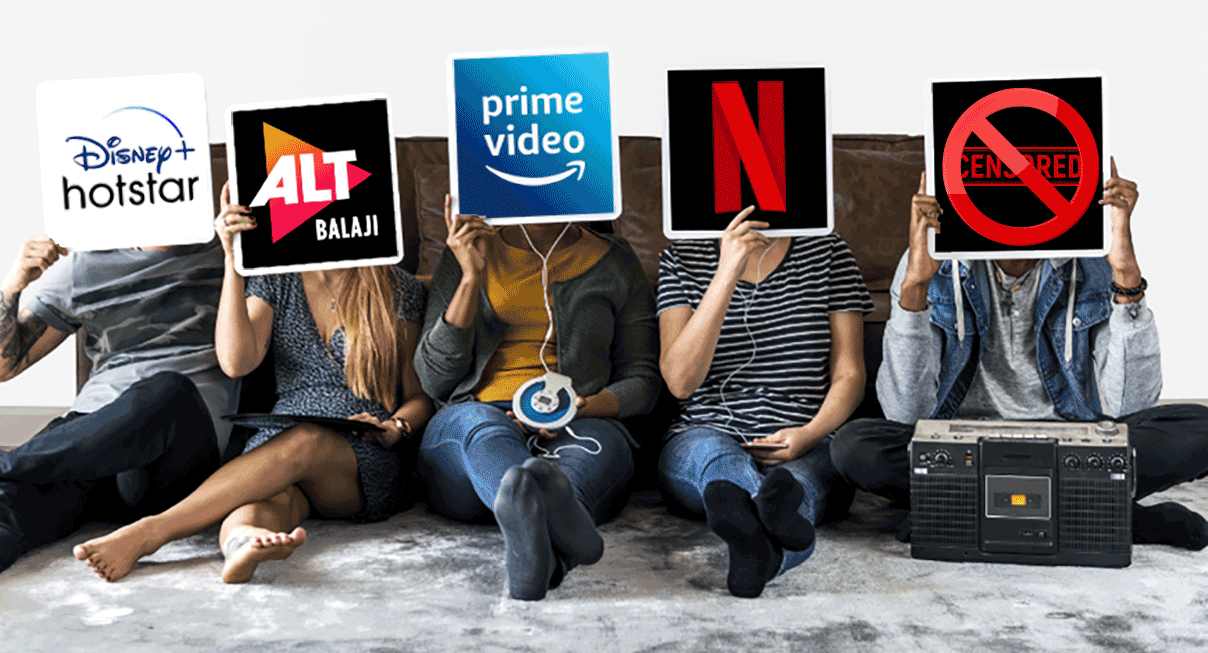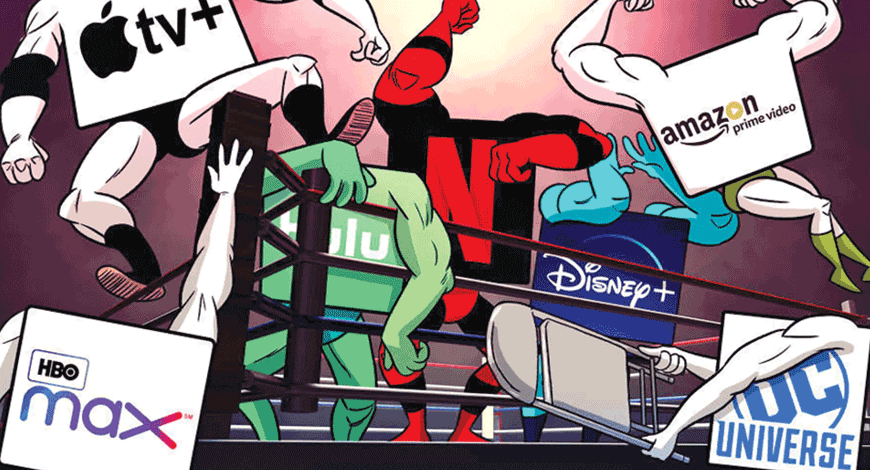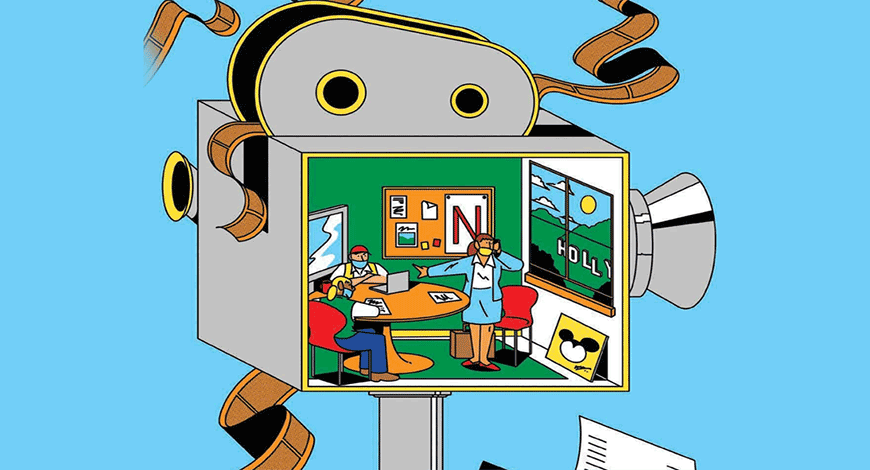CT Stories
Uncertainty ahead despite double-digit growth

As cinema halls take a back seat, with the pandemic refusing to relent, there is an unprecedented boom in the OTT market across the globe. Just like it is with the rest of the world, OTT viewership in India is at an all-time high now. While OTT platforms were making a mark for themselves in the Indian market, the COVID-19 crisis accelerated the process. From just two OTT platform providers in 2012 to about 40 players now, the OTT revolution has come a long way in India.
The media and entertainment industry in India are growing rapidly, and the country is expected to join the global top 10 shortly. The overall media and entertainment sector is expected to be valued at `3.22 lakh crore by FY2025 expanding at a CAGR of ~10 percent during the FY2020-25 period. The digital media segment which includes OTT services is on the cusp of disruption. Despite the OTT market being at a nascent stage, its services have found widespread acceptance in the country. The Indian video OTT market was valued at `4250 crore in FY2019 and is expected to reach `23.7 thousand crore by FY2025, expanding at a CAGR of ~33.10 percent.
The majority of Indian households have a single TV per household. However, as part of the Digital India plan, the government has been investing in high-speed broadband enterprises to amplify broadband coverage and adoption which is crucial for OTT video success. Therefore, the availability of affordable data has created an alternate medium where consumers, can tap into any content, any time, at any place on a device of their choice as per their convenience. With the necessary infrastructure being put in place it is but obvious the sector will grow at this pace.
Premium, original content is one of the biggest growth drivers and differentiators in the industry with a number of OTT platforms competing for consumers attention. Netflix, Amazon Prime Video, Disney+ Hotstar, MX Player, JioTV, Voot, SonyLIV, and ALTBalaji are some of the major video OTT platforms in the market. The industry also includes players like Manorama Max, Hoichoi, Addatimes, Primeflix, Ullu, and Sun Nxt, which are capitalizing on the core regional content.
In 2019, Disney+ Hotstar with global streaming and concurrent viewership records, accounted for the highest market share (~23.8%) as India’s leading digital-streaming platform based on app installation, along with highest app reach, followed by MX Player (~41.4%), and Jio TV (34.08%).
In 2019, there were around 170 million video OTT-streaming users in India and the user base is expected to increase at a rate of about 26 percent till 2025. The industry players are heavily investing in acquiring or developing new content and services, and are also focusing on improving customers experiences. Based on the different types of revenue models adopted by market players, the market is segmented into AVoD, subscription SVoD, freemium, and TVoD. The AVoD model accounted for the major chunk (~69.23%) of the total market revenue generated by video OTT players in FY 2019. Original content in regional languages is anticipated to become the major game changer for video OTT players since it is expected to bring in viewers willing to pay subscription prices.
Amid the nationwide lockdown, OTT platforms in the country witnessed a substantial surge in terms of content consumption and subscriber count, and hence are now striving to meet viewers swelling appetite for entertainment. The average time spent by a subscriber on an OTT platform has increased from about 20 minutes to at least one hour during recent times. To meet the increasing demand and reduce internet congestion, OTT platforms including Disney+ Hotstar, SonyLIV, ALTBalaji, Amazon Prime Video, Netflix, and ZEE5 unanimously cut down high definition picture quality (1080p & 720p) bitrate to standard definition picture quality (480p).
The pandemic has led to the rural India opening a new distribution channel. With increased internet penetration in the rural areas, OTT players are keen on developing regional content to cater to the rural markets. Lack of other entertainment options has spurred audiences (mostly from Tier-II and Tier-III cities) who had not discovered OTT viewing, until the pandemic struck, are adapting to these platforms. While most of them are first-time samplers, platform owners are trying to increase customer stickiness by bringing in a variety of content to cater to the increased content viewing appetites.
2Q20

Up until last year, Amazon Prime and Netflix were still playing catch-up in the Indian market. Now, the coronavirus pandemic seems to have accelerated the often-seen scenario of international players pushing out local pioneers. According to JustWatch, Netflix and Amazon Prime Video captured a fifth of the market each in 2Q20, while the cooperation of Disney+ and local player Hotstar reached 17 percent. As recently as 2019, Hotstar alone still had a market share of almost 30 percent while Amazon Prime Video and Netflix captured only 10 percent and 5 percent of the Indian market, respectively.
The Indian small screen has also been attracting attention during the COVID-19 pandemic as a place where new Bollywood productions have been released–either as original material or as a last resort while cinemas remain shuttered. According to the BBC, Netflix has released 18 Indian-made originals this year, while Amazon Prime is looking at bringing out 14 in 2020. Disney+ Hotstar, in a different approach, would host seven movies that were originally headed for the big screen.
Despite the newfound dominance of international players, the Indian streaming market remains fragmented, with a slew of local brands still taking up nearly half of the market. The new Disney+ Hotstar service stands out as a brand which combines Disney’s global streaming endeavor with Hotstar’s Indian programming and cricket league broadcasting rights. Hotstar’s parent company, Star India, has actually been owned by Disney since 2019, when Disney purchased 21st Century Fox.
OTT proves troublesome for pay TV
While the country has a number of local streaming services, India, with its high population, is increasingly becoming a battleground for western players. India’s pay TV industry is expected to see a CAGR of 0.7 percent from USD 3.1 billion in 2020 to USD 3.30 billion in 2025, according to GlobalData. Pay TV services revenues are likely to decline by 0.6 percent year-on-year in 2020 due to pandemic-caused cord-cutting.
The pay TV industry landscape and the market dynamics have shifted dramatically, and the COVID-19 pandemic has accelerated the need for further change. Hence, operators in the country have also been focusing on offering OTT content as a bundled service with pay TV plans in an effort to drive subscriptions–a trend of content aggregation that has also been evident in more established western markets.
WarnerMedia has announced that it will discontinue HBO and WB in India and four other South Asian countries from December 15, 2020. The closure of HBO and WB, both strong brands, is an indicator of the increasing grip of OTT platforms in India.
Sports content has traditionally been the largest contributor to the revenues for all pay TV services. The disruption of sports broadcasting due to COVID-19 has led to significant erosion of revenue for operators and pay TV providers. Yet at a time, when social distancing norms have disrupted live sports, Disney+ Hotstar VIP have given great joy to a cricket-crazy nation.
The telecom playbook

Traditional media has always suffered from the 50:50 dilemma where the advertisers bemoaned the fact that 50 percent of the money, they spent on advertising, was lost and they did not know which half. However, this traditional media age, characterized by scarcity, saw advertising ruling the roost, with ad revenues contributing disproportionately to the share of the overall revenue pie.
Come digital, and Google and Facebook defined what a modern-day media company looks like, with much greater power in the hands of the consumers, as also advertisers with sophisticated advertising tools. This precision-based personalized targeting at scale, with more accurate and powerful determinants linking advertising with results, catapulted Google and Facebook to create the ad duopoly in worldwide markets and relegate traditional media to a minion self of what it was at a point in time.
Television, however, continued to put up a good fight. That is till recently in the US and perhaps not for long, in India. Television itself is now undergoing a metamorphosis of sorts with the substantial power of distribution as a key attribute of success plucked out by the OTT outrage.
There was a time when value-added services accounted for a large play that created a major competitive differentiator and source of revenue for the telecom players. Over a period of time, the price wars and competition from digital and social media made such differentiation irrelevant and telecom went mostly the commoditized way.
OTT subscriptions have become the latest weapons in India’s telecom war. India’s telecom price war is back after a hiatus and the battle is being fought on freebies. At `6.7 per gigabyte (GB), the average cost of mobile data in India is the cheapest in the world, according to the Worldwide Mobile Data Pricing report for 2020 by UK-based Price comparison firm Cable.co.uk. With the proliferation of smartphones and the availability of internet connectivity at an affordable rate coupled with extended lockdowns and its repercussions, OTT has become the next normal in the world of entertainment.
OTT platforms are the contemporary version of the value-added services of the past for telecom players. It is Jio which is leading the charge here. In the last one month, Jio has announced the bundling of 12 OTT platforms, which includes almost all major players, for its JioFiber broadband and most recently for postpaid-plus services. And there is a similar offer from Airtel Xstream broadband as well.
Does this position Jio as an aggregator for the OTT industry? What happens to the OTT players? Why are OTT players allowing an outsider to come and disrupt the market? How do users benefit from the unified, aggregated content destination? And will Jio help or hurt the OTT platforms?
Jio solves major problems that users face on OTT platforms namely search, ease of payment, remembering multiple accounts and passwords, and a one-click login facility across platforms.
With content consumption being dependent on data connection, telecom players have a sure-shot way of realizing enhanced average revenue per user. The OTT market also benefits with more and newer audiences from Tier-II and Tier-III cities as also older viewers. The OTT players get more penetration. While the consumer benefits with connectivity, which is today needed for both entertainment and work.
According to a 2020 EY-FICCI report, India’s telecom industry is poised to become the primary platform for content distribution and consumption. OTT content has become the key selling point for telecom companies. What remains to be seen is whether all telcos offer the same package and consumers end up with a price war once again, or whether there will be some differentiation and customization provided to consumers.
The new-age business models driven by the success of platforms are all increasingly looking the same: aggregating the consumers, engaging the consumers, and monetizing the consumers. That is how sometimes a consumer could either be the customer or the product. In a venture capital driven modern world with deep pockets at one’s disposal, the two elements of aggregating the consumers and monetization are easy to solve with the cost of acquisition and a customer’s lifetime value. It is the engagement bit which is difficult to crack.
In an age of consumers increasingly spoilt by the offer of the best at the least price, the consumers are raking it all and harbor no loyalties. It is, therefore, important to keep them engaged as that is where the value creation and capture can finally be monetized. This is where content play becomes the sole differentiator. And so, the fight is being played out at the OTT outpost.
The regulatory angle
Recently, the debate about regulation and censorship has been heating up in India. Some believe OTT content has gone too far and needs to be regulated and censored. There is the other side of the argument where others believe there should not be any censorship on the internet.
There is an accelerated adoption of paid streaming content in households as telecom companies have started offering OTT services bundled with broadband packages. This is helping content platforms reach and build a family audience base as they stream shows on the big screens at home.
According to the PHD Chamber, control on OTT content is a must, on account of the disruption of healthy and meaningful content in some OTT platforms which are giving away messages related to violence, crime, and other inappropriate content leading to negativity in the minds of young audience. Hence, they laid emphasis on the need for the intervention of the government, through stringent regulations like the formation of censorship board to minimize the usage inappropriate content by the industry players to save the Indian culture and social values.
On the contrary, the Telecom Regulatory Authority of India (TRAI) has offered some relief to OTT and cloud companies with its recent decision that OTT communication services do not currently need a regulatory framework. Net neutrality lobbyists are pleased; however, a number of telecom companies, many of which have asked for regulation of apps that offer free voice and text services over the internet, are dissatisfied.
The TRAI has asserted that it is not an opportune moment to recommend a comprehensive regulatory framework and that no regulatory intervention is needed on issues related to privacy and security of OTT services. It has also recommended setting up an industry body for cloud service providers–possibly through the Department of Telecommunications (DoT)–as part of a light-touch regulatory framework. Such a body would require all cloud service providers (CSPs) to become its members.
Already, there has been a fair share of content censorship such as Netflix’s decision to remove the episode of the Patriot Act, which was critical of the Crown Prince of Saudi Arabia. In another instance, Netflix released a censored version of Angry Indian Goddesses in India, while releasing an uncensored version internationally. There are many similar instances, and this trend will only grow.
Way forward

OTT platforms have helped keep the sanity intact in these difficult times by being a major source of entertainment. Almost every streaming service under the sun is offering free trials and consumers are lapping up the trials. The streaming wars were already getting hotter but under Covid-19 lockdowns, it has come to the forefront. But the outlook remains uncertain for most operators.
Advertising-based services may see their ad inventory increase as viewing hours increase, thereby allowing their revenues per viewer to grow as costs grow. OTT providers like Netflix, Amazon, and YouTube that have their own CDNs are in a better position to control their delivery costs than OTT providers that rely on third-party CDN providers.
The near-term outlook, in general, could be rosier for free, ad-supported services, although a protracted economic decline might also cause advertisers across the board to scale back their digital ad spend. Hence, some SVoD services might see a bump in new subscribers, if quarantines drag on for months and consumers dig deeply into available services looking for new content.
Many OTT platforms have taken their sweet time to completely disrupt this space, not just in India or the United States, but across the globe. The factors fueling this growth are not only the innovation in technology but also innovation in the storyline, which is currently free from any regulation or censorship.
Streaming content should follow the food industry model, meaning content should have full disclosures about its contents and allow the consumer to decide if they want to purchase or watch it.
Currently, all major streaming players are following their own standards, but in the future, there will be a need of a regulatory body that standardizes these disclosures and uses technology to audit for compliance, without censoring any content. Here, artificial intelligence and machine learning could play a big role in automatically classifying the content and generating full disclosures about the content about to be consumed.
The next decade in streaming will be very exciting and also very challenging. Winners will not only be decided by who has the best content but also who has the most advanced technology to make the service more intelligent and easier to use. Ultimately, the streaming wars will empower consumers and also revolutionize how they consume media.













You must be logged in to post a comment Login